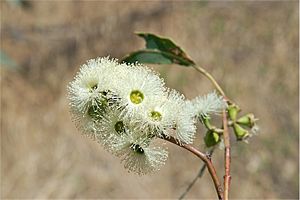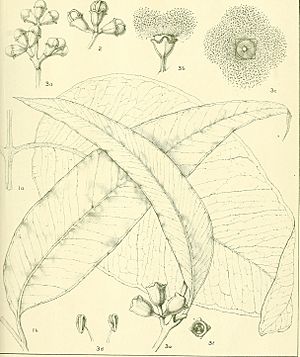Darwin stringybark facts for kids
Quick facts for kids Darwin stringybark |
|
|---|---|
 |
|
| Flowers of Eucalyptus tetrodonta | |
| Scientific classification | |
| Genus: |
Eucalyptus
|
| Species: |
tetrodonta
|

The Darwin stringybark (scientific name: Eucalyptus tetrodonta) is a medium-sized to tall tree. It is found only in northern Australia. This tree has rough, stringy bark on its trunk and branches. Its leaves are shaped like a spear and grow in pairs. It has flower buds in groups of three, and its flowers are whitish or cream-coloured. The fruit looks like a small cylinder.
Contents
What Does the Darwin Stringybark Look Like?
The Darwin stringybark tree usually grows to be about 9 to 25 meters (30 to 82 feet) tall. It has a special woody swelling at its base called a lignotuber. This helps the tree regrow after a fire. Its bark is rough, fibrous, and stringy. It is grey over a reddish-brown colour on both the trunk and branches.
Leaves and Flowers
Young plants and new shoots (called coppice regrowth) have egg-shaped leaves. These leaves are a dull bluish-green on both sides. They grow in opposite pairs and are about 150 to 350 mm (6 to 14 inches) long. They are also about 35 to 120 mm (1 to 5 inches) wide.
Adult leaves are also dull bluish-green on both sides and grow in opposite pairs. They are shaped like a spear or are slightly curved. These leaves are 90 to 240 mm (4 to 9 inches) long and 10 to 35 mm (0.4 to 1.4 inches) wide. They narrow down to a leaf stalk, called a petiole, which is 11 to 26 mm (0.4 to 1.0 inches) long.
The flower buds grow in groups of three. They are found where the leaf meets the stem (called a leaf axil). Each group of buds grows on a short stalk called a peduncle, which is 3 to 17 mm (0.1 to 0.7 inches) long. Each individual bud has its own tiny stalk, called a pedicel, up to 9 mm (0.4 inches) long.
Mature buds are oval or pear-shaped. They are 8 to 13 mm (0.3 to 0.5 inches) long and 6 to 12 mm (0.2 to 0.5 inches) wide. They have a rounded cap, called an operculum. Sometimes, this cap has four small ridges or "ribs" on its sides.
Flowering and Fruit
The Darwin stringybark flowers between June and September. Its flowers are whitish or cream-coloured.
After flowering, the tree produces a woody, cylindrical fruit. This fruit is a type of seed pod called a capsule. It is 12 to 20 mm (0.5 to 0.8 inches) long and 9 to 17 mm (0.4 to 0.7 inches) wide. The fruit has three or four openings, called valves, that are level with its rim. The seeds inside are grey, flattened, and oval-shaped, about 2 to 4 mm (0.08 to 0.16 inches) long.
How Was it Named?
The Darwin stringybark was first officially described by a botanist named Ferdinand von Mueller in 1859. He wrote about it in a scientific journal called Journal of the Proceedings of the Linnean Society, Botany.
The scientific name, tetrodonta, comes from two ancient Greek words. "Tetra" means "four," and "odonta" means "a tooth." This name refers to the four small "teeth" or ribs that are sometimes seen around the rim of the fruit's cap. The closest relative to this tree is another eucalyptus species called E. megasepala.
Where Does it Grow?
The Darwin stringybark is found in northern Australia. It grows in the Kimberley region of Western Australia. Here, it prefers flat areas and plateaus. It grows in sandy soils that are often found over laterite (a type of soil rich in iron and aluminum), sandstone, or quartzite (hard, non-foliated metamorphic rock).
Its range stretches eastward across the top end of the Northern Territory. It also grows in parts of the Gulf of Carpentaria and the Cape York regions in North Queensland. You will usually find it as part of open forests or woodlands.
Is it Protected?
Good news! The Darwin stringybark is not considered to be in danger.
- The Western Australian Government's Department of Parks and Wildlife says it is "not threatened."
- The Northern Territory Government also lists it as "least concern" under their Territory Parks and Wildlife Conservation Act 2000.
- The Queensland Government also calls it "least concern" under their Nature Conservation Act 1992.
This means there are enough of these trees, and they are not at risk of disappearing.
See also
 In Spanish: Eucalyptus tetrodonta para niños
In Spanish: Eucalyptus tetrodonta para niños

